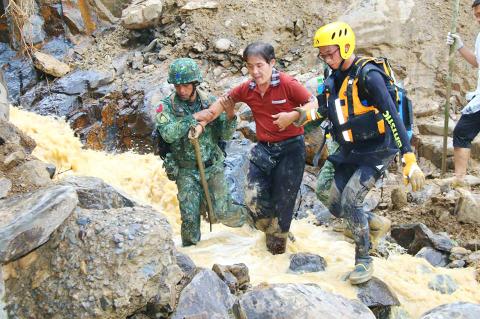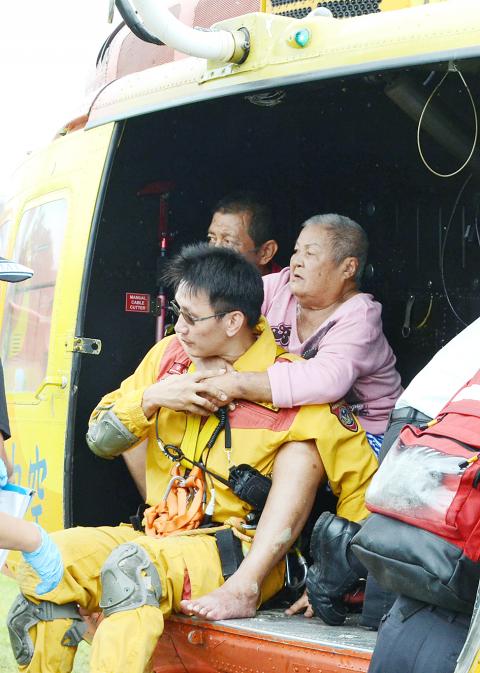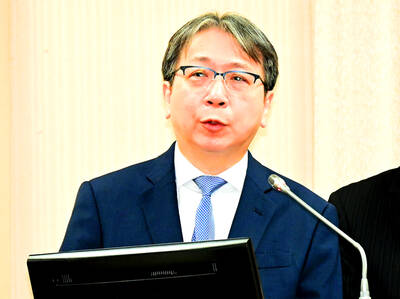The nation yesterday struggled to recover from the devastation caused by Typhoon Soudelor, with about 240,000 households nationwide still left without electricity as of press time last night.
The Central Weather Bureau lifted both sea and land warnings for Typhoon Soudelor at 8:30am yesterday after it moved toward China’s Fujian Province. Statistics from the Ministry of the Interior showed that the strongest typhoon the nation has faced this year killed seven people and left five missing.
The number of people injured during the typhoon had risen to 402.

Photo: CNA
Taiwan Power Co (Taipower, 台電) said in a written statement said that work to restore power was restricted because either road access to disaster-stricken zones was cut off or power facilities were covered by fallen trees, adding that it had to wait for highway authorities and local governments to remove obstacles so that work could begin.
Taipower said that about 4.3 million households had experienced power failure on Saturday because of the typhoon, the highest number that the company had ever handled, adding that the number had dwindled to 236,980 by 7:16pm.
The National Airborne Service Corps was dispatched to airlift 13 people from the mountainous area in New Taipei City’s Wulai District (烏來) to receive medical treatment as the area remained cut off from the rest of the city because of severely damaged roads. Helicopters were also sent to deliver 700kg of food and other life-sustaining items to residents in the area. A photograph taken from an airborne helicopter showed that the river in Wulai had burst its banks.

Photo: CNA
Hot-spring pipelines on both sides of the river were destroyed by the flood.
The Directorate-General of Highways said that the section between Kueishan Bridge (龜山橋) and Wulai on the Highway No. 9 — the only way to reach Old Street in Wulai — suffered serious erosion of the roadbed, adding that reconstruction work can only be completed using heavy machinery. It estimated that Wulai would not be accessible to the general public until Sunday.
To assist the New Taipei City Government in rescuing people still trapped in Wulai, the Ministry of National Defense sent 36 members of the Army Special Combat Forces and four Hummers.
While the rest of the nation managed to weather the storm, clean water supply also became an issue.
Many supermarkets were sold out of bottled water as people finding tap water too turbid to use searched for cleaner alternatives.
The Taipei Water Department said that the turbidity of the water from the Sindian River (新店溪), which is a source of tap water, had at one point escalated to 30,000 nephelometric turbidity units (NTU), or five times more than the maximum capacity of the water treatment facility.
Though the turbidity had dropped to 4,500 NTUs, people are advised to boil water before drinking it, the department said.
Taiwan Taoyuan International Airport has had to deal with a huge backlog of flight passengers, as 366 flights were canceled on Saturday due to the arrival of the typhoon.
It said that 120,000 passengers were at the airport yesterday, which is equivalent to the volume that the airport saw during the Lunar New Year holiday. In addition, agricultural damage caused by Typhoon Soudelor was estimated at NT$600 million (US$18.9 million).
The government received a total of 23,953 disaster reports from the public. A total of 6,470 cases were related to fallen trees, which was the highest among all the other disaster categories.

The US government has signed defense cooperation agreements with Japan and the Philippines to boost the deterrence capabilities of countries in the first island chain, a report by the National Security Bureau (NSB) showed. The main countries on the first island chain include the two nations and Taiwan. The bureau is to present the report at a meeting of the legislature’s Foreign Affairs and National Defense Committee tomorrow. The US military has deployed Typhon missile systems to Japan’s Yamaguchi Prefecture and Zambales province in the Philippines during their joint military exercises. It has also installed NMESIS anti-ship systems in Japan’s Okinawa

‘WIN-WIN’: The Philippines, and central and eastern European countries are important potential drone cooperation partners, Minister of Foreign Affairs Lin Chia-lung said Minister of Foreign Affairs Lin Chia-lung (林佳龍) in an interview published yesterday confirmed that there are joint ventures between Taiwan and Poland in the drone industry. Lin made the remark in an exclusive interview with the Chinese-language Liberty Times (the Taipei Times’ sister paper). The government-backed Taiwan Excellence Drone International Business Opportunities Alliance and the Polish Chamber of Unmanned Systems on Wednesday last week signed a memorandum of understanding in Poland to develop a “non-China” supply chain for drones and work together on key technologies. Asked if Taiwan prioritized Poland among central and eastern European countries in drone collaboration, Lin

ON ALERT: Taiwan’s partners would issue warnings if China attempted to use Interpol to target Taiwanese, and the global body has mechanisms to prevent it, an official said China has stationed two to four people specializing in Taiwan affairs at its embassies in several democratic countries to monitor and harass Taiwanese, actions that the host nations would not tolerate, National Security Bureau (NSB) Director-General Tsai Ming-yen (蔡明彥) said yesterday. Tsai made the comments at a meeting of the legislature’s Foreign Affairs and National Defense Committee, which asked him and Minister of National Defense Wellington Koo (顧立雄) to report on potential conflicts in the Taiwan Strait and military preparedness. Democratic Progressive Party (DPP) Legislator Michelle Lin (林楚茵) expressed concern that Beijing has posted personnel from China’s Taiwan Affairs Office to its

BACK TO WORK? Prosecutors said they are considering filing an appeal, while the Hsinchu City Government said it has applied for Ann Kao’s reinstatement as mayor The High Court yesterday found suspended Hsinchu mayor Ann Kao (高虹安) not guilty of embezzling assistant fees, reducing her sentence to six months in prison commutable to a fine from seven years and four months. The verdict acquitted Kao of the corruption charge, but found her guilty of causing a public official to commit document forgery. The High Prosecutors’ Office said it is reviewing the ruling and considering whether to file an appeal. The Taipei District Court in July last year sentenced Kao to seven years and four months in prison, along with a four-year deprivation of civil rights, for contravening the Anti-Corruption